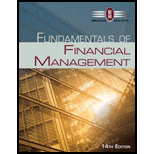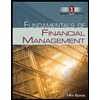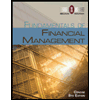
Fundamentals of Financial Management (MindTap Course List)
14th Edition
ISBN: 9781285867977
Author: Eugene F. Brigham, Joel F. Houston
Publisher: Cengage Learning
expand_more
expand_more
format_list_bulleted
Concept explainers
Question
Chapter 9, Problem 8TCL
Summary Introduction
To calculate: The range of intrinsic values of shares of the company on the basis of different values of estimated dividend for next year, the rate of
Introduction:
Sensitivity Analysis:
It refers to the calculation of the values of a particular variable on the basis of different values of other variables on which the particular variable is dependent. In other words, in sensitivity analysis, the range of values of a particular variable is computed on the basis of different values of other variables or inputs.
Expert Solution & Answer
Trending nowThis is a popular solution!

Students have asked these similar questions
43
-ACC-121-71: CH 04 HW-X
Question 7 - CH 04 HW - Exercise X
ezto.mheducation.com/ext/map/index.html?_con=con&external_browser=0&launchUrl=https%253A%252F%252Fconnect.mheducation.com%252Fcon
vo Support L Lenovo McAfee
Dashboard | Piedm...
Information System...
My Shelf | Brytewav...
My Shelf | Bryteway...
Exercises & Problems
Saved
Help
Sa
Scribners Corporation produces fine papers in three production departments-Pulping, Drying, and Finishing. In the Pulping
Department, raw materials such as wood fiber and rag cotton are mechanically and chemically treated to separate their fibers. The
result is a thick slurry of fibers. In the Drying Department, the wet fibers transferred from the Pulping Department are laid down on
porous webs, pressed to remove excess liquid, and dried in ovens. In the Finishing Department, the dried paper is coated, cut, and
spooled onto reels. The company uses the weighted-average method in its process costing system. Data for March for the Drying
Department…
With the growing popularity of casual surf print clothing, two recent MBA graduates decided to broaden this casual surf concept to
encompass a "surf lifestyle for the home." With limited capital, they decided to focus on surf print table and floor lamps to accent
people's homes. They projected unit sales of these lamps to be 7,600 in the first year, with growth of 5 percent each year for the next
five years. Production of these lamps will require $41,000 in net working capital to start. The net working capital will be recovered at
the end of the project. Total fixed costs are $101,000 per year, variable production costs are $25 per unit, and the units are priced at
$52 each. The equipment needed to begin production will cost $181,000. The equipment will be depreciated using the straight-line
method over a five-year life and is not expected to have a salvage value. The effective tax rate is 21 percent and the required rate of
return is 23 percent. What is the NPV of this project?
Note:…
Forest Enterprises, Incorporated, has been considering the purchase of a new manufacturing facility for $290,000. The facility is to be
fully depreciated on a straight-line basis over seven years. It is expected to have no resale value after the seven years. Operating
revenues from the facility are expected to be $125,000, in nominal terms, at the end of the first year. The revenues are expected to
increase at the inflation rate of 2 percent. Production costs at the end of the first year will be $50,000, in nominal terms, and they are
expected to increase at 3 percent per year. The real discount rate is 5 percent. The corporate tax rate is 25 percent. Calculate the NPV
of the project.
Note: Do not round intermediate calculations and round your answer to 2 decimal places, e.g., 32.16.
NPV
Chapter 9 Solutions
Fundamentals of Financial Management (MindTap Course List)
Ch. 9.A - For a stock to be in equilibrium, what two...Ch. 9.A - If a stock is not in equilibrium, explain how...Ch. 9.A - RATES OF RETURN AND EQUILIBRIUM Stock Cs beta...Ch. 9.A - EQUILIBRIUM STOCK PRICE The risk-free rate of...Ch. 9.A - BETA COEFFICIENTS Suppose Chance Chemical Companys...Ch. 9 - It is frequently stated that the one purpose of...Ch. 9 - Is the following equation correct for finding the...Ch. 9 - Prob. 3QCh. 9 - Two investors are evaluating GEs stock for...Ch. 9 - A bond that pays interest forever and has no...
Ch. 9 - Discuss the similarities and differences between...Ch. 9 - This chapter discusses the discounted dividend and...Ch. 9 - DPS CALCULATION Warr Corporation just paid a...Ch. 9 - CONSTANT GROWTH VALUATION Thomas Brothers is...Ch. 9 - CONSTANT GROWTH VALUATION Harmon Clothiers stock...Ch. 9 - NONCONSTANT GROWTH VALUATION Hart Enterprises...Ch. 9 - CORPORATE VALUATION Smith Technologies is expected...Ch. 9 - PREFERRED STOCK VALUATION Fee Founders has...Ch. 9 - Prob. 7PCh. 9 - PREFERRED STOCK VALUATION Ezzell Corporation...Ch. 9 - PREFERRED STOCK RETURNS Bruner Aeronautics has...Ch. 9 - VALUATION OF A DECLINING GROWTH STOCK Martell...Ch. 9 - VALUATION Of A CONSTANT GROWTH STOCK A stock is...Ch. 9 - VALUATION OF A CONSTANT GROWTH STOCK Investors...Ch. 9 - CONSTANT GROWTH You are considering an investment...Ch. 9 - NONCONSTANT GROWTH Microtech Corporation is...Ch. 9 - CORPORATE VALUATION Dozier Corporation is a...Ch. 9 - NONCONSTANT GROWTH Milts Cosmetics Co.s stock...Ch. 9 - CONSTANT GROWTH Your broker offers to sell you...Ch. 9 - NONCONSTANT GROWTH STOCK VALUATION Taussig...Ch. 9 - CORPORATE VALUATION Barrett Industries Invests a...Ch. 9 - CORPORATE VALUE MODEL Assume that today is...Ch. 9 - NONCONSTANT GROWTH Assume that it is now January...Ch. 9 - Comprehensive/Spreadsheet Problem NONCONSTANT...Ch. 9 - Prob. 23ICCh. 9 - Estimating Exxon Mobil Corporation's Intrinsic...Ch. 9 - Prob. 2TCLCh. 9 - Estimating Exxon Mobil Corporation's Intrinsic...Ch. 9 - Prob. 4TCLCh. 9 - Estimating Exxon Mobil Corporation's Intrinsic...Ch. 9 - Prob. 6TCLCh. 9 - Prob. 7TCLCh. 9 - Prob. 8TCLCh. 9 - Prob. 9TCLCh. 9 - Prob. 10TCL
Knowledge Booster
Learn more about
Need a deep-dive on the concept behind this application? Look no further. Learn more about this topic, finance and related others by exploring similar questions and additional content below.Similar questions
- Beta Company Ltd issued 10% perpetual debt of Rs. 1,00,000. The company's tax rate is 50%. Determine the cost of capital (before tax as well as after tax) assuming the debt is issued at 10 percent premium. helparrow_forwardFinance subject qn solve.arrow_forwardPlease help with questionsarrow_forward
arrow_back_ios
SEE MORE QUESTIONS
arrow_forward_ios
Recommended textbooks for you
 Fundamentals of Financial Management (MindTap Cou...FinanceISBN:9781285867977Author:Eugene F. Brigham, Joel F. HoustonPublisher:Cengage Learning
Fundamentals of Financial Management (MindTap Cou...FinanceISBN:9781285867977Author:Eugene F. Brigham, Joel F. HoustonPublisher:Cengage Learning Fundamentals of Financial Management (MindTap Cou...FinanceISBN:9781337395250Author:Eugene F. Brigham, Joel F. HoustonPublisher:Cengage Learning
Fundamentals of Financial Management (MindTap Cou...FinanceISBN:9781337395250Author:Eugene F. Brigham, Joel F. HoustonPublisher:Cengage Learning EBK CONTEMPORARY FINANCIAL MANAGEMENTFinanceISBN:9781337514835Author:MOYERPublisher:CENGAGE LEARNING - CONSIGNMENT
EBK CONTEMPORARY FINANCIAL MANAGEMENTFinanceISBN:9781337514835Author:MOYERPublisher:CENGAGE LEARNING - CONSIGNMENT- Principles of Accounting Volume 1AccountingISBN:9781947172685Author:OpenStaxPublisher:OpenStax College
 Fundamentals Of Financial Management, Concise Edi...FinanceISBN:9781337902571Author:Eugene F. Brigham, Joel F. HoustonPublisher:Cengage Learning
Fundamentals Of Financial Management, Concise Edi...FinanceISBN:9781337902571Author:Eugene F. Brigham, Joel F. HoustonPublisher:Cengage Learning Fundamentals of Financial Management, Concise Edi...FinanceISBN:9781285065137Author:Eugene F. Brigham, Joel F. HoustonPublisher:Cengage Learning
Fundamentals of Financial Management, Concise Edi...FinanceISBN:9781285065137Author:Eugene F. Brigham, Joel F. HoustonPublisher:Cengage Learning

Fundamentals of Financial Management (MindTap Cou...
Finance
ISBN:9781285867977
Author:Eugene F. Brigham, Joel F. Houston
Publisher:Cengage Learning

Fundamentals of Financial Management (MindTap Cou...
Finance
ISBN:9781337395250
Author:Eugene F. Brigham, Joel F. Houston
Publisher:Cengage Learning

EBK CONTEMPORARY FINANCIAL MANAGEMENT
Finance
ISBN:9781337514835
Author:MOYER
Publisher:CENGAGE LEARNING - CONSIGNMENT

Principles of Accounting Volume 1
Accounting
ISBN:9781947172685
Author:OpenStax
Publisher:OpenStax College

Fundamentals Of Financial Management, Concise Edi...
Finance
ISBN:9781337902571
Author:Eugene F. Brigham, Joel F. Houston
Publisher:Cengage Learning

Fundamentals of Financial Management, Concise Edi...
Finance
ISBN:9781285065137
Author:Eugene F. Brigham, Joel F. Houston
Publisher:Cengage Learning
Efficient Market Hypothesis - EMH Explained Simply; Author: Learn to Invest - Investors Grow;https://www.youtube.com/watch?v=UTHvfI9awBk;License: Standard Youtube License